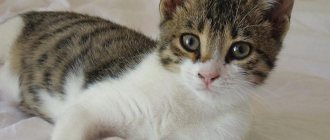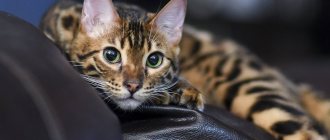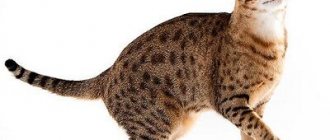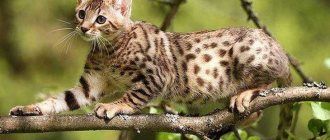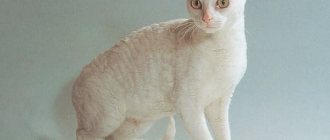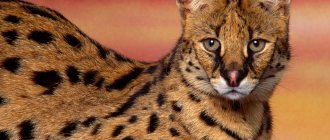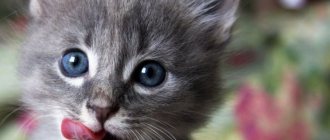Video
* We invite you to watch a video about the Bengal cat . In fact, in front of you is a playlist in which you can select and watch any of 20 videos about a given cat breed by simply clicking on the button in the upper right corner of the window. In addition, the material contains quite a lot of photos. By looking at them you can find out what a Bengal cat looks like.
In this article:
|
Rate the material!
[Total votes: 2 Average: 5]
The Bengal cat is a mini-leopard that lives right in your apartment. This unusually graceful, charming lady is very smart and courageous, she can become a devoted comrade, a reliable loving friend for her owner. There is no aggression in the character of the Bengals, but there are many interesting features, so it is worth understanding them in more detail.
Nutrition
Bengal cats are carnivores. Often, cat owners (of any breed) forget about this obvious fact. Look at commercial foods and you will see that they contain very little meat, a lot of corn, wheat, soy, potatoes, rice. These types of feeds have only been around for about 60 years. So why are they so in demand? The answer is obvious - they are cheap. Do these foods provide enough nutrients for the cat to survive? Yes. Will my cat thrive on this food? No and no again. The most reliable alternative to such nutrition is natural meat, fish, and vegetables.
Give your Bengal cat plenty of natural foods. Sometimes owners are perplexed: “How can you feed a cat only meat or fish, and even raw?” This is the most natural food for her; we don’t think anyone believes that for the previous 9,000 years the cat ate exclusively dry food and canned food.
History of the origin of Bengal cats
The history of the origin of the Bengal cat breed dates back to 1961, when American Jean Mill, a biologist, went to the capital of Thailand, where Bengals live in the wild. At that time, the state of the population of these amazing animals was completely deplorable, they were on the verge of extinction. Ruthless hunting in pursuit of beautiful skins destroyed a huge number of cats, and kittens became a trade item, in demand among tourists.
Jean Mill could not pass by and bought herself such a beautiful pet, which she took with her to the USA. To the woman’s surprise, the kitten turned out to be calm, did not show aggression, but was not affectionate either, avoiding people, staying apart. But the Bengal cat found a common language with the domestic cat that lived with Jean, accepting his courtship during the mating season.
Soon the unusual couple had healthy offspring with a bewitching coat color. This is how the idea arose of creating a cat breed that would have all the habits of an ordinary domestic cat, but would have an original exotic color. This interesting idea was brought to life already in 1991, when the newest breed was presented at a large international animal exhibition. It was only towards the end of the twentieth century that the TICA (International Cat Association) registered a new Bengal cat breed.
Many other cat breeds were involved in the process, including:
- Persian;
- Abyssinian;
- American Shorthair, etc.
At first, luck was not at all on the side of biologists. The cubs were born sickly and quickly died from various ailments. Experienced geneticists did not despair and were able to understand the reasons for their failures, developing an excellent Bengal breed that did not suffer from lack of health at all.
Everything worked out as planned - the cat got her appearance and courage from her wild relatives, and her affectionate disposition from her mustachioed pets. This amazing cat was first brought to our country in 1997 and was loved by many Russians for its extraordinary, chic appearance and excellent character.
Bengal cat - description of the breed
For domestic cats, the weight of Bengals is quite substantial. In males it reaches 9 kg, and females are slightly lighter - from 5 to 7 kg. These amazing creatures live for about 15 years.
There are a number of special prescribed standards that the appearance of a true Bengali must meet. The cat's head is of medium size, wedge-shaped, the chin is quite massive, and the whisker pads are plump and massive. The high-set ears with rounded tips have a light spot on the outside, and their bottoms are wide and solid.
The cheek area, with the ear pads located on it, is voluminous and plump. The muscular, elongated body has a strong skeleton and a strong, wide neck. Contrasting wide nose with a slightly curved shape. The eyes are almond-shaped, with colors ranging from green to golden.
Silky short coat with a glossy sheen and beautiful spots that evenly cover the entire body; the color can be gray, red or white. Cubs may have slightly longer fur than adult animals. The tail is dense, medium length, spotted. Strong paws are round in shape, the hind legs are longer than the front ones.
The extraordinary leopard-print appearance of the Bengal cat is simply mesmerizing; you can simply admire it ad infinitum. Looking at it, you may get the impression that the animal is a little aggressive, but this is completely deceptive. These mustachioed creatures, on the contrary, are very good-natured and sociable, unlike their wild ancestors, from whom they inherited their exotic and irresistible appearance.
Popular colors of Bengal cats
The color of a Bengal cat is its calling card, so it is worth focusing your attention on this feature of the animal. The cat's face is beautifully lined with a pattern of bright dark stripes in the shape of the letter "M". The pads on which the mustache is located are light in color.
Interesting fact: The nose, eyes and lips are outlined, have a dark edging and stand out beautifully against the lighter tone of the muzzle. There are also bright dark stripes on the neck, decorating it like a necklace. The tail is strewn with spots or rosettes, and is always black at the tip.
The color of the fur of Bengal cats varies in several ways: this is the general color background of the animal and the type of pattern on this background.
The most common colors:
- Golden;
- Silver;
- Snow (this color includes: sepia, lynx, mink).
The charcoal color is considered unusual and very rare; Bengals also have a blue color. As for the patterns applied to the fur coat of cats, they can also be divided into separate subspecies.
The patterns are:
- Spotted - monochromatic dark spots cover the entire body of the cat;
- Rosette - the rosettes have a dark edge, and inside are painted in a lighter tone than the outline itself, but darker than the general background of the coat. Sockets also come in different sizes, their circuit may or may not be closed;
- Marble - such patterns are represented by bright stripes and stains, which are located horizontally. Patches located in a circle or vertically are considered a fault of the breed.
The most common and favorite color by many is golden, which has a general background of warm shades (golden, yellowish, reddish). The pattern on the body has black, brown and chocolate shades. When the rosette is clearly visible and large in size, then this color is considered the most successful and valuable. The second place in popularity is occupied by a silver background, also with spots or rosettes.
It is worth noting that the marble pattern is fully formed only by the age of two years of the animal’s life. And marble on a silver background is considered a very rare color and difficult to breed. Minx Snow Bengals have one distinctive feature - their eyes can be a bright blue color. Charcoal colors are considered rare, and the rarest are blue, which were officially recognized not so long ago. The fur of a Bengal cat has an extraordinary shine (glitter), which plays in the light, all this thanks to the empty hair shafts, which reflect the light, shimmering beautifully.
Cat, cat and kittens
A relatively new and controversial breed, the Bengal is rapidly growing in popularity, partly due to its wild cat appearance. Bengals are a hybrid breed created by crossing an Asian leopard cat with a domestic cat. The first "domestic leopard" appeared in Japan in the early 1940s, and Bengal cats first appeared in the United States in the 1970s. As a breed, Bengals were first presented at exhibitions in 1985. Today, the International Cat Association recognizes the Bengal cat as the most popular breed, overtaking the second-place Ragdoll cat. However, the Cat Fanciers' Association, the largest registry of cat breeds in the world, does not recognize the Bengal as a separate breed.
The Bengal is not an ordinary cat. The beauty of this breed is undeniable, their coat is spotted or marbled, smooth and shiny, like satin. The uniqueness of the Bengal cat also lies in the fact that its fur seems to be strewn with golden sparkles, which looks simply amazing in the sunlight. They say that this fur does not cause such an allergic reaction as other cat breeds. Bengals are very intelligent and have a mischievous nature. Although your housework may take twice as long, you will never be bored - your pet will “help” make the bed and sweep. The most important thing is that when you buy a Bengal, you immediately begin training him so that he knows what behavior is acceptable and what is not. An untrained cat will cause chaos throughout the house if it does not know the boundaries of what is permitted. Fortunately, Bengalis learn very quickly. It is also easy to train these cats to walk on a leash like dogs. The main thing is to start as early as possible, training will be more successful with kittens.
physical characteristics
Bengals stand out among other cats with their beautiful, thick and surprisingly soft coat. They have a leopard color, there are spots or rosettes on the fur, and there is also a marble pattern. The spots should be in sharp contrast with the background color. Some have amazingly sparkling fur, as if sprinkled with gold or pearls.
They are long, muscular, athletic, medium to large sized cats, with a broad wedge-shaped muzzle, high cheekbones, a wide nose and prominent whisker pads. The eyes are round, wide, with dark rims around them, the ears are small and rounded at the ends. The hind legs are slightly longer than the front ones.
Brief information about Bengal cats:
- Weight: 4.5 – 7 kg.
- Length: 40 cm.
- Ideal for active families and experienced cat owners;
- Suitable for families with other pets, including dogs;
- They have beautiful leopard-colored fur;
- Athletic and sporty;
- They can meow a lot and loudly;
- Highly intelligent;
- Demanding;
- They love water;
- Show class Bengals can cost several thousand dollars;
- Reach maturity by two years;
- They love shiny objects that they can steal and hide.
Despite its growing popularity, the Bengal cat is certainly not a cat for everyone. It is suitable for experienced owners who are willing to devote a lot of time to playing and interacting together every day. Bengalis demand attention. They are quite talkative. Their vocal repertoire is very varied, ranging from simple meows, chirps, howls to growls, hisses and guttural sounds. Some growl when they eat. You may have some problems with feeding such a pet. He always has to be the first to get to his food, so he often gets into grocery bags before you even have time to unpack them, yummy items like chicken are guarded proudly with a low growl!
Interaction with children
People often think that because they are wild, Bengal cats will be difficult to handle and that they are dangerous to children, but the opposite is true. Breeders claim that Bengals are gentle and affectionate, although they will never be “kneeling” cats. However, they enjoy human company and will often be around family members. The Bengal cat especially enjoys the company of children, as both the energetic Bengal cat and children love to play. Bengalis are endlessly loyal to their family members. They love attention and are completely safe for children. My only advice: Bengals are very active and dynamic cats that will not sit on your lap. Therefore, it is important to teach your children not to limit the cat’s freedom. These pets will follow your family members around the house and will always be present where the fun is. They love to play with children. Warnings - these cats are so energetic that they can accidentally scratch people while playing and jumping. This is not a problem for most cat lovers, but can be a problem with small children.
Devoted family members
Bengal cats have a close emotional bond and psychological closeness with family members and require attention. Bengalis love to talk a lot. They meow, chirp and howl. This way, you can even talk to them and they will be happy to answer you. They really love spending time with their families. In this sense, they are unique compared to other cats, who are often aloof and very independent. In fact, Bengal cats are similar to dogs in this personality trait.
These cats simply love interaction with people and need to receive as much attention as possible. If you live in an apartment and spend all day at work, a Bengal cat is not for you. It’s good when a cat of this breed has access to a fenced area or a protected attic, where you can walk in the open air and watch the birds. This is a very muscular cat, loves to run, and climbs trees very well.
Bengals are often compared to dogs. They are so active and intelligent that they need interaction with other creatures and mental stimulation, so it is preferable to keep them with another cat or dog. Bengals must have a lot of toys, play sets, they must be constantly entertained by playing with a rope, a laser beam, and all kinds of household items to keep their minds occupied. If they have nothing to do, they will follow you around the house and actively “help” you with whatever you are doing. Bengal cats are active, energetic and have high intelligence. They study the actions of their owners and learn how to open cabinets, doors and even windows. They are able to climb walls, refrigerators and other high places in the house.
If you are used to sleeping without cats, you may need to change your habits. Bengals are able to learn to open a bedroom door by jumping up and pressing the handle with their paw until it opens. If they don’t succeed, you will hear their loud dissatisfaction. This cat doesn't like to be ignored!
They are extremely smart. They come when called and will play with you until they (or you) get tired. You should dedicate some time to playing with them daily, just like you would an energetic dog - otherwise all their energy will be directed towards your furniture, toilet paper, chandeliers, etc. At the same time, they are very gentle and affectionate pets.
Some say that Bengals are one-owner cats. They are faithful companions, filling a person’s life with love and happiness if a person is ready to give a lot of attention and affection in return. They “imprint” with one person to whom they remain faithful throughout their lives.
Curiosity
Cats of this breed have an innate curiosity and very high intelligence. They are avid travelers. Bengals are easy to train and can learn many tricks if you choose to train them. Another aspect of their personality that is a direct result of their intelligence and curiosity is their self-confidence. If they want something, they will get it. So don't worry when you see overturned cans or open cabinets - all this was done by your beloved Bengal in search of his toy or treat that you hid from him.
Activity and dynamism
Bengal cats are very dynamic and active. They easily jump onto doors and cabinets, and jump from great heights. They are always running, chasing, jumping, catching, chasing and so on. These traits were inherited from their wild ancestors. However, they can also be affectionate and gentle. This is a cat that is always up for adventure and will always be there when something happens.
One of the traits of Bengals, inherited from their wild ancestors, is a strong hunting instinct - they can hunt not only small land animals, but also aquatic inhabitants. The leopard has honed its ability to fish in the wild, and your pet Bengal may well do this in a more playful manner, taking a shower or bath, or simply playing in the sink with running water. In addition, Bengals like to climb as high as possible, so remove fragile items from open shelves and general access if you want to keep them safe and sound.
However, don't worry, at times when Bengals are relaxing, they can be very gentle, affectionate, calm and peaceful. They can lie on their back, they can come up to you and snuggle with their muzzle, purring wildly and, finally, they can curl up into small balls and sleep soundly. They truly crave love and will spend many happy hours of relaxation with you, lying around and purring. They will wake you up at night, rubbing their muzzle against you, hugging you with their paws, and will sleep with you until the morning. All this perfectly complements the moments of activity of the Bengali.
Love for water
Bengalis often have a special love for water. This is a very common personality trait that is a direct inheritance from their wild ancestors. They are attracted to running water and are not afraid to get into water and will go into the shower or bath, jump on the sink and play with running water, and sometimes even play with water in the toilet. They can also dispense water from a bowl or drinking fountain.
Here are some of the things Bengalis can do. If this behavior makes you smile or laugh, this is the breed for you. If this behavior irritates you and causes rejection, then the Bengal is not your breed.
1. This cat is unlikely to sit on your lap for long. Most of them are too busy, because there is so much interesting in the world besides your lap.
2. Bengals are very jumping, they make huge jumps, both in length and in height. Some of them can jump onto the refrigerator in one jump. During such jumps, they can throw various trinkets, flower pots, lamps, curtains onto the floor. They jump onto countertops and tables in the kitchen, and it can be quite difficult to wean them off.
3. Like other cats, Bengals love to look out the window, so it is better to provide them with this opportunity until they provide it themselves.
4. All of their toys are temporary, you will have to continue to buy them periodically because most will be under the stove, refrigerator, or anything else that makes them difficult to remove.
5. Some Bengal cats like to play with toilet paper - unwinding the rolls and tearing the paper into pieces.
6. Bengals love to play with water. Some use their paws to hit the surface of the water (for example, in their drinking bowl), which splashes everywhere.
7. Bengal cats can chew things like dogs.
8. This cat breed has large, strong legs and long claws. In addition, they love to jump on people from heights. When they land on your shoulder or back and feel they are losing their balance, they dig their claws into you. Nice?
9. Bengalis don't like closed doors, especially when they want to get somewhere. They will meow and scratch the door until it opens.
10. They like to sleep with their owner either under the blanket or on it. Some sleep on their owners, anywhere from head to toe.
11. Some people like to chew paper, especially important receipts that you didn’t have time to hide.
12. Some cats are not averse to rummaging through your trash can.
13. They can lead an active night life. While you are sleeping, they may well open the cabinet in your kitchen and get something tasty, knock something over, break it, etc.
14. Cats love to sharpen their claws, so you will need a tall, secure scratching post.
15. Bengals are smarter than the average cat. They watch people and learn to open doors, fetch things like dogs, and get to places that cats are not meant to go to.
After reading all this, by your reaction you will understand whether this breed is for you. True Bengali lovers enjoy telling such stories to their friends and acquaintances. If you are already dreaming about the naughty antics of your own Bengali, you will be a good owner. If you don’t understand why you should have such an active cat, choose a calmer and more obedient breed and think carefully about whether you need a cat at all.
Bengals are smart, lively, active cats with whom owners develop a very close, genuine two-way bond. These cats will not sit on the sidelines, ignore you, or sit quietly. Their nature makes them unsuitable for people who want a quiet, calm, unobtrusive pet. They are suitable for people who want a more "canine" family member. Bengal cats make excellent companions to active families with other pets. For those who want an active pet, but are not ready for daily walks with the dog. They are also great for families who want a unique and special cat that has the appearance of a wild animal on the outside but is loving and gentle on the inside.
Additional information about this breed can be found here.
Character and habits of Bengal cats
Bengals are by nature very friendly and wise creatures, endowed with a playful disposition and extraordinary devotion to their owner. It is better not to get such a pet if you go on business trips for a long time, because the cat is very bored, and this traumatizes its psyche, it may think that you have betrayed it and completely forgotten it. The animal remains on guard with unfamiliar people, but with its beloved owner it is ready to go anywhere.
Bengals are very playful and active by nature, especially up to eight months of age, so vigorous play is very important for them. Cats are always attracted by the unknown, so they can climb up to the very ceiling on furniture, exploring the entire space of the apartment. Some breeders equip the house with special ladders to prevent the animal from damaging the furniture.
At first, it is better to take your pet out on a leash, then he can learn to walk on his own and easily find his way home, because his intelligence is well developed. Many owners do not allow cats to walk independently, because... fear for the life of their pets, so they walk them themselves so that the pet is under reliable supervision.
Interesting fact: An unusual feature of the Bengal breed is its love of water treatments. Unlike ordinary domestic cats, a Bengal cat does not need to be lured into the bath by cunning; she herself goes for a swim with pleasure, receiving pleasure from it.
You should not be afraid or expect aggression from Bengals; they only superficially resemble a leopard, but their soul and character are calm, peaceful and flexible. Nature also endowed them with intelligence, so the animals are very smart and easy to train. Give them your tenderness, affection and love, and in return you will receive the same, only in even greater quantities.
Bengal character
The Bengal kitten is sociable and, with proper care, grows into a friendly and playful pet. Such an animal has a sociable and courageous disposition, diligent and devoted to its household members. Cats of this breed follow their owner and require attention.
Bengals are a socialized breed without aggression. You can admire these charming creatures and their habits for hours, although semi-wild genetics still sometimes manifest themselves in the form of a stubborn temperament.
Bengal cats are playful and active. It is better to protect household appliances and furniture from them so that they are not used as sports equipment or for sharpening claws. To do this, they buy special scratching posts and ladders for your pet so that they actively develop, release their energy and demonstrate their grace and dexterity.
Do you love dogs as much as I love them? Read the description and features of my favorite breed here
It is better to place your pet’s rest house higher up, as kittens and adult cats love to be at heights and keep an eye on those around them. They are constantly exploring unknown corners in the house, so it is better to close the basements from them, strengthen the windows and put bars and nets on them. Small predators get along well with other pets, but at the same time they demonstrate their superiority.
Bengal cats can be trained as they have high intelligence. They willingly carry out the simplest commands.
There are no rodents in the house where the Bengal lives, as the cat has excellent hunting abilities. If your pet is not given proper attention, it can also become aggressive.
Interesting facts about Bengal cats
Bengal cats have many of their own interesting features and habits that are extraordinary and different from other cat breeds. Let's try to make a list of some of the unique features of Bengals, listing them by number.
One of the amazing facts about them is their love of bathing, which is not typical for other domestic cats. Activity is the strong point of Bengals, they are omnipresent and always active, so there should be plenty of toys and fun in the apartment.
Climbing is second nature to them; they will climb wherever others cannot climb. The leash does not bother them at all; they easily adapt to it, although this can be problematic for other breeds. Loyalty and boundless devotion to their master, for whom they are ready to follow, even to the ends of the earth.
Bengals are not ashamed of having friendly relations with dogs, but, on the contrary, welcome them, because this is another reason to play with a friend. In many ways, their character traits are similar to those of dogs. These cats, like magpies, love to take shiny things (jewelry, hairpins, keys) and hide them in secluded places. So, the right thing can be found unexpectedly in a place where it was even difficult to imagine.
Hunting can never be eradicated from the character of whiskered creatures, so you should be wary of the birds if they live in your home. Having acquired a small Bengal, do not be upset about the dull color of his coat and completely faded pattern - this is a temporary phenomenon, which is called “phasing”. Usually it is observed until the age of five months, then the color appears clearly and richly. This property comes from feline ancestors; it helps small kittens better camouflage in the wild;
Sociability is the main trait of animals. They have a lot of diverse sounds in their arsenal with which they express their feelings. This can be either a gentle purr and a quiet meow, or a loud call and even a roar. Good nature, boundless tenderness, friendliness - these are the striking features of the beautiful Bengali nature.
Pros and cons of Bengal cats
Almost every breed of pet has its own advantages and disadvantages, so those who are thinking about getting a pet should think about all these nuances and weigh the pros and cons so that there is no doubt about the choice. Bengal cats also have their own positive and negative habits and characteristics that cannot be ignored.
Advantages of the Bengal cat breed:
- A good-natured character is the key to a good upbringing;
- The intelligence and resourcefulness of the animal;
- Bengals do not cause allergies and are not subject to shedding;
- They adore their owner;
- They are easily trained and accustomed even to an ordinary human toilet;
- They enjoy water treatments, which makes them similar to Maine Coons;
- The beauty of their appearance can cover all existing flaws;
- The shiny sheen of the silky coat is simply enchanting;
- They bring a lot of games, fun and a great mood to their owners.
Cons of Bengal cats:
- Excessive activity, especially of young animals, can cause significant damage to the apartment, so many acquire a special enclosure where the animal is temporarily placed while no one is home;
- If a Bengal kitten has not been properly raised, then it may be wild and not make contact; it is very difficult to tame such an animal normally, it may remain a savage forever;
- Almost all males put their stinking marks, so it is recommended to resort to castration if you are not going to breed Bengal cats, otherwise life will be simply unbearable, the cat can happily mark the owner, denoting him as his property;
- Females also mark during estrus, so many resort to sterilization. Tags can be avoided if you get two Bengal pets of different sexes at once.
If you are determined to get yourself such an unusual exotic pet, then be fully prepared, having studied in detail all the positive and negative aspects of communicating and living with them, then your ward will feel at ease, cozy and comfortable with you. Think in advance about how much time you can devote to your mustachioed pet, because it will take a lot of it, carefully calculate your strength.
Appearance of the breed
If we talk about the appearance of the Bengal, then it is a small, rather graceful, elegant-looking cat, but with a strong and developed body. Very similar to a leopard, thanks to the identical spotted colors.
Head
The head is small, slightly elongated, and has a rounded outline. The ears are small, with rounded ends. The eyes are oval, deep-set, and can be any color except aquamarine and blue.
Frame
An elongated body, with medium-length limbs and rounded, powerful paws. Withers height is 25-32 cm.
Color
Several types of color are allowed, namely:
- black, silver tabby;
- marble;
- spotted;
- snow.
Weight
On average, females weigh about 4-6 kg, and males - 5-8 kg.
Little leopard
How long do they live?
The health of the Bengal breed is quite strong, and if you follow all the rules of care, the cat can live from 12 to 15 years. Life expectancy depends on the genetics of the animal.
Pros and cons of the breed
Undoubtedly, even the most ideal pets have their advantages and disadvantages. The advantages of Bengals include the following:
- ability to learn commands;
- loves to play;
- feels the mood of the owners;
- Can be given to allergy sufferers.
But these animals have certain disadvantages:
- do not like to be petted or picked up;
- may meow or play too loudly.
Breeding Bengal cats
Breeding Bengal cats has certain nuances and difficulties, so first-time breeders should understand this delicate issue in detail. You cannot mate with other breeds, otherwise the cat will lose its individuality and acquire traits unusual for its pedigree.
Bengal cats become sexually mature at approximately nine months of age. For the first mating, it is better that the partner is experienced and has given birth more than once. In females, the mating period can begin as early as five months of age. During the period of growing up and maturation, the character of pets can be more capricious and unstable, so they simply need even more care, affection and tenderness from the owner.
Interesting fact: Bengals easily find mutual understanding with other pets, becoming friends even with dogs with whom they are not averse to frolicking. The mustachios love walks in the fresh air; after all, their ancestors have a wild and unbridled disposition.
Mating of animals should take place in the territory where the male lives, so that he feels more confident and not afraid. Females are more tolerant of changes in the environment and behave adequately in new conditions. After about a month, you will notice the first signs that the cat is pregnant.
A mustachioed mother usually gives birth to 4 babies. Don't forget about phasing so as not to get upset ahead of time. Remember that kittens only acquire their rich color and unmatched pattern over time, so be patient. Kids should feel love and care not only from their mother, but also from their owners, this is important!
How to choose a kitten and where to buy it
It is recommended to buy kittens only in specialized nurseries for breeding Bengal cats for two reasons.
Firstly, certified breeders only offer healthy kittens for sale whose pedigree can be traced. One of the advantages of nurseries is that they reject individuals that do not meet the socialization requirements and are not allowed for breeding.
Secondly, kittens that are less than six months old do not look as presentable as adult Bengals - their hair is longer and does not shine. That is why, at the poultry market, instead of a Bengal kitten, there is a high risk of purchasing a kitten of only a similar color, but not purebred. And this takes into account the fact that a Bengal kitten costs at least 35–40 thousand rubles.
When choosing a kitten, you must request a veterinary passport, where vaccination notes must be made.
Be sure to look at the kitten’s appearance and behavior. If the kitten is absolutely healthy, then, like any child, it will be curious, cheerful and playful, it will make contact easily and will not show aggression.
It is also practiced in nurseries to reserve kittens, which makes it possible to follow the kitten you like from a few weeks of its life until three months - the moment when you can buy and take the kitten home.
Caring for Bengal cats
Bengals have very good immunity; they rarely complain about their health. It is necessary to visit the veterinarian from time to time to get vaccinations. If the animal often walks outside, then treatment for all kinds of parasites is very important. These beautiful animals are unpretentious in care. Their coat is short, so they do not need daily brushing.
It is enough to do this 1-2 times a week. Bengals' nails are trimmed a couple of times a month. The ears are cleaned with a regular cotton swab dipped in water. There are no problems with bathing at all; they do this with great pleasure, willingly agreeing to any water procedures. Taking care of your teeth now is not particularly difficult, because pet stores sell all kinds of special bones that clean plaque.
All other requirements are typical for any pet; they need to be loved, fed and never abandoned. You should not expose cats to severe hypothermia; excessive stuffiness also has a bad effect on them. Make sure that there is always a comfortable and friendly atmosphere in your home. The pet's food must also be of proper quality.
An important condition for spending time with such a pet is active play, which they simply adore, so be prepared to spend a lot of time playing cat games, otherwise the cats themselves will find entertainment that can negatively affect your interior.
Important fact: Bengals are very clean, so their litter box must be kept clean so that they do not find a more secluded, clean place for it. You will have to clean the potty several times a day, although a cat can be trained to use the toilet, if you approach this matter thoroughly, then there will be much fewer problems with cleaning.
Bengal cat diet
Bengals have a rather weak digestive system, so their diet must be formulated correctly to avoid unpleasant consequences. If you give preference to natural products, then they should always be fresh, low-fat, and the content of spices in them is undesirable. Rabbit meat, beef, turkey, and lean chicken are perfect for the everyday menu. Boiled fish may also be on the menu, but not more than several times a month. It is better to avoid very bony river fish.
Important fact: Mandatory components of the diet should be fermented milk products, which strengthen not only the animal’s bone tissue, but also have a beneficial effect on the coat. It is better to treat older Bengal cats with minced meat; vitamins must be present in the diet.
It is much easier to feed your pet with special dry food that is already balanced and fortified. It is worth carrying out the feeding procedure 3 – 4 times a day. A prerequisite for such feeding should be water, which is always available to the pet. You need to make sure that the bowl with it is never empty, the cat’s health depends on this, because urolithiasis may occur.
It is up to you to decide which feeding method to choose for your pet; you can consult your veterinarian about this. The main thing here is the free time that the owner has. If he has a lot of it, then the method of feeding him with natural products is no worse than dry food, the main thing is to properly balance the menu, and for this you will have to work hard.
Dry food is much easier to manage, so this feeding method is suitable for busier owners. Typically, Bengal cats do not overeat, they always know when to stop, so obesity in this breed is extremely rare.
Care
Bengal cats do not pose any problems when it comes to care; for this reason, there are no specific care recommendations. The Bengal cat is easy and unpretentious to care for. However, you need to perform such standard actions as: combing the fur, cleaning the ears, trimming the claws.
They are clean and practically do not shed. If you want, it’s easy to bathe them, because they are not at all afraid of water. These cats, due to their natural activity, need walks. If you live in a small apartment, you will sometimes have to walk your pet so that he can run around and exercise. Cats quickly get used to the harness and happily go for walks.
Diseases and health problems
It is believed that the Bengal cat breed has a fairly strong immune system, so their health is excellent, although some problems do occur. The weak point of Bengals is their weak stomach, so their diet should be taken very seriously.
There is no need to mix natural foods and dry food; this has a negative effect on the digestive system of animals. Even switching to another brand of dry food should be done smoothly and gradually so as not to harm a cat with a very sensitive stomach.
Recently, breeders have been complaining about other diseases that have begun to occur more and more often in animals. Kittens began to be born with flat chest syndrome, and in adult animals hypertrophic cardiomyopathy is observed.
Bengals also have inherited diseases: leukemia, numerous growths (cysts) in the kidneys, thickening of the heart muscle. Owners should take careful care of their pets and regularly undergo routine examinations by a veterinarian so as not to develop the disease, if it is detected, and begin the treatment process in a timely manner
We select a kitten
Despite the fact that there are now a lot of offers for purchasing Bengal kittens on various advertisement sites, it is still recommended to purchase your pet only from special nurseries.
When buying a kitten, be sure to carefully study the documents for the cat. The Bengal must have a veterinary passport, which will indicate all the procedures performed on him. Pay attention to the fact that there are marks about vaccinations and anthelmintic measures.
The kitten for sale is 3 months old. As a rule, he should already learn to play, eat and wash himself.
Bengal kitten
